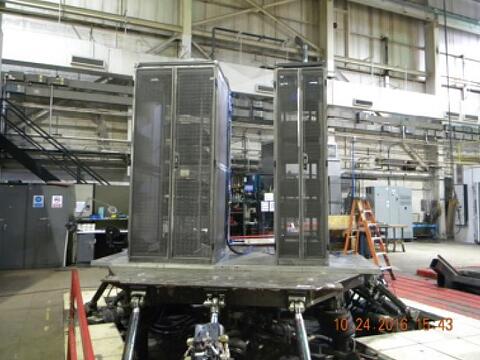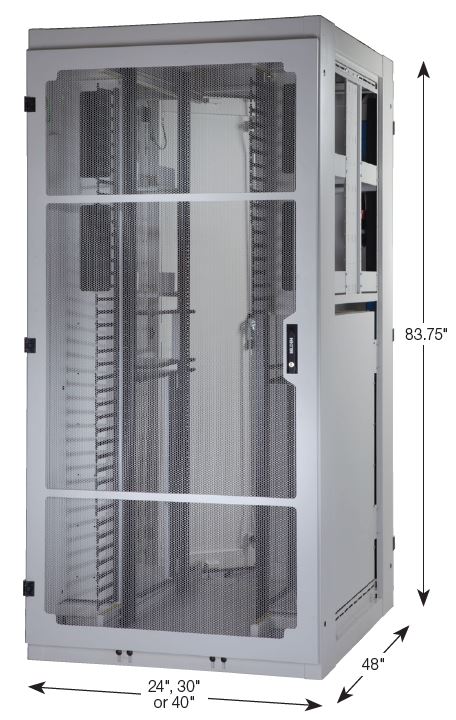Seismic Ratings for Cabinets: Reducing the Risk of Downtime
The International Building Code (IBC) dictates that certain facilities – data centers often included – remain operational during and after earthquakes or other seismic events. Based on building type, and how essential a building’s operations are, facilities are placed into four IBC-determined risk categories:
- Risk Category 4: Hospitals, aviation control towers, police/fire stations, facilities containing highly toxic materials
- Risk Category 3: Lecture halls, theaters, power-generations stations, water treatment plants, prisons
- Risk Category 2: buildings that don’t fall into Risk Categories 1, 3 or 4
- Risk Category 1: storage buildings and agricultural facilities
Data centers typically fall into Risk Category 4, which means that their operation is considered vital during and after an earthquake. To protect against downtime, it’s important to reduce the potential for equipment damage during seismic events – especially if data centers aren’t backed up at a secondary location. Some data centers are considered vital to maintaining communication exchange (wireless, email, voice, etc.) after a seismic event.
What are Seismic Ratings?
To secure and protect server, data storage and network equipment, and prevent components from moving or overturning during an earthquake, cabinets with seismic ratings are available.
A seismic rating indicates how well a standalone cabinet, two-post rack or four-post rack can protect active equipment and reduce damage during heavy vibration. Higher seismic ratings indicate performance ability based upon the intensity of the seismic event. A Zone 4 rating, for example, indicates a cabinet that can tolerate the highest level of movement. Cabinets with seismic ratings can also minimize movement that causes cable-connection strain.
 Telcordia is one of two organizations that provide cabinet standards for seismic ratings. It also ranks geographic regions based on the likelihood of an earthquake or seismic activity (a cabinet’s seismic rating is based on these zones):
Telcordia is one of two organizations that provide cabinet standards for seismic ratings. It also ranks geographic regions based on the likelihood of an earthquake or seismic activity (a cabinet’s seismic rating is based on these zones):
- Zone 1: areas least prone to earthquakes or seismic activity
- Zone 2: areas that experience very little ground acceleration
- Zone 3: areas that experience some ground acceleration
- Zone 4: areas near active fault lines that are most prone to earthquakes or seismic activity
Zone 1 is the least intense; Zone 4 is the most intense. Cabinets with a Zone 4 seismic rating, for example, are designed to protect active equipment against damage during major earthquakes or other seismic activity. Many people think that Zone 4 must only include the West Coast, but the map above shows the potential for major seismic events in certain Canadian areas – and even Minnesota.
Seismic bracing is also an approach used in data centers. This can involve using anchors, transverse braces, longitudinal braces, vertical supports and threaded rod stiffeners to keep components from moving during earthquakes. Building codes provide requirements for seismic bracing as well.
Standards for Seismic Events
To protect people and assets, U.S. regions that experience seismic events follow strict building codes and guidelines for buildings. The seismic products installed in these buildings must also comply with guidelines – including data center cabinets.
As mentioned earlier, there are two organizations that dictate standards for seismic cabinets: Telcordia and IBC. This table compares the two organizations’ standards.
|
|
Telcordia GR-63 |
IBC |
|
Purpose |
Guidelines for cabinet protection level to ensure that networks remain active during earthquakes. |
Mounting guidelines so equipment doesn’t tip over during earthquakes. |
|
Application |
Not site-specific. |
Site-specific (standards vary from city to city, state to state, etc.). |
|
Testing |
Third-party testing facilities conduct a shaker table test to simulate an earthquake, shaking in every direction at varying levels of intensity to represent different zones (Zones 1-4). |
Three options: 1) math equation to compare potential seismic effects to objects in the building, 2) experience data showing that the cabinet has performed in an earthquake or 3) shaker table test |
|
Installation |
Cabinet mounted to floor with concrete expansion anchors. Keep cabinet’s center of gravity low when loading. Ganged cabinets are more stable. |
Cabinet mounted to floor with concrete expansion anchors. Keep cabinet’s center of gravity low when loading. Ganged cabinets are more stable. |

Due to the stringent compliance testing of GR-63, all cabinets that are compliant with GR-63 are also IBC compliant.
Cabinets with Seismic Ratings: What to Look For
To ensure that they offer a stable base for active equipment, there are certain features you should look for in seismic cabinets:
- Heavy-duty doors with high-quality hinges and at least three latch points
- Steel frame construction reinforced with a heavy-gauge steel sub-frame for strength
- Full welding to increase rigidity and reinforce the frame
- Perforated doors with stiffener channels for better durability and reduced equipment damage
- Locking nuts and washers to strengthen rack-mounted components
- Integrated/reinforced floor-mount locations
It’s important to note that seismic cabinets typically don’t offer castors or levelers.
Anchoring for seismic cabinets depends on the application’s flooring. Working with an expert to properly and securely anchor a seismic cabinet to the floor is very important. Otherwise, the cabinet won’t perform as expected during a seismic event.

Seismic Cabinets from Belden
Belden’s seismic cabinets and racks (2-post and 4-post) were tested by an independent lab and meet Telcordia GR-63-Core Zone 4 requirements. A robust steel frame protects servers, switches and network components. Shaker table testing conducted by a certified third-party lab showed no structural damage. This means that the cabinets withstood a simulated earthquake, which involves shaking in every direction at varying levels of intensity. Belden also offers seismic two-post and four-post open racks.
If you have questions about whether your facility needs seismic cabinets, or what type of seismic cabinets to use, we can help. Contact us today!
